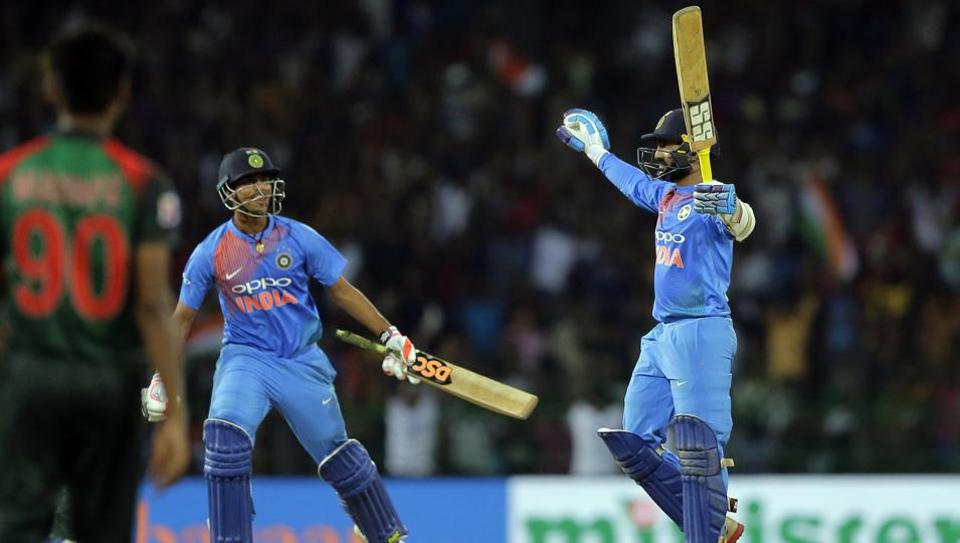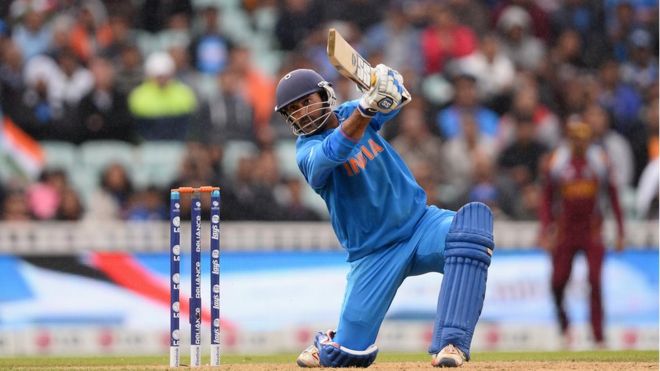New Delhi, March 20 (Indian Express): A day after his historic night, in which he peeled off the most thrilling 29 runs in India’s T20I history, Dinesh Karthik relives and deconstructs his knock in this interview with The Indian Express. Excerpts:
When you connected that shot off the last ball, it went for a flat six. Did you ever doubt that it would be a six?
I knew I had connected very well and it really went very flat. The ground in Sri Lanka is big. As soon as I hit it, I got the feeling that it’s going because the ball had hit the centre of the bat, and the bat didn’t turn (in my hand) also. But since it went too flat, somewhere there was a little bit of doubt. It went a little over the rope.
Let’s retrace. What was going on in your mind when Vijay Shankar had those dot balls in 18th over off Mustafizur Rahman?
Look, every cricketer has gone through a phase where he tries to hit but can’t connect on a certain day. He (Shankar) was trying to connect with the ball but his timing was not coming through. Every batsman who has played this sport has gone through that. It takes a lot of nerve; it was unlucky for him as this was the first time he had batted for Team India. In a final, under pressure, things didn’t happen for him. But it’s an amazing learning for him. Based on my chat with him, that boy has taken it in a positive way, and I genuinely wish that he can go on to achieve big things in life.
In the press conference, Rohit Sharma said you were a bit angry about being asked to bat a bit down the order.
I was a little shocked. Angry is a bit strong word, I feel. The whole tournament I had batted at No. 6 and then to see Shankar go up, I was a little bit shocked. I have a good rapport with Rohit – under his captaincy I have won the IPL. I obviously trust him a lot. I know he respects me as a cricketer. I was more shocked than angry – bit disappointed, yes. It was more like, ‘are you sure about the move as Vijay hasn’t batted the whole tournament?’ I knew there must be a reason behind it.
What was going through your mind in the dugout?
I couldn’t predict how the game will go but it was certainly a tough pitch to bat on. They were bowling good lines; even in the previous league match, when we played them, they had kept things tight. It took 40 to 42 balls for a batsmen of Rohit’s calibre to get 50 in the last game. They bowled in a disciplined way, they had plans for every batsman and executed it well. Sunday was no different.
What was the thought when you walked out to bat?
I was just thinking to hit every ball for a boundary, as simple as that. There was nothing else you could do other than try to get a boundary off each ball. In the dugout, I was sitting next to R Sridhar, the fielding coach, who said we need one big over, two big overs etc. By the time I went in, we needed two big overs—there was no other way. Every ball had to matter at that stage.
What did you tell Vijay Shankar then?
I walked in and told Vijay to try to hit a boundary: That is instead of looking to hit a six, try and look to hit a four. My thinking was if he tried to get a boundary at that stage, he could hold his shape and not slog too much. Luckily, he got the crucial boundary in the 20th over.
Can you tell us how the first ball you faced went for a six?
The previous game I played, he (Rubel Hossain) had bowled a yorker to me and the ball was also reversing. I knew that he will try a yorker again. I wanted to get under the ball, so that I can get some elevation. So I stood ahead of the crease. Usually I stay deep but I went forward this time—the idea was to try to connect with the ball as early as possible to get the elevation. And I hit it well over long on.

The second ball you faced, you managed a four?
I just wanted to hit that ball in the gap; so I stood still, used my crease so that I could find the gap, and luckily the ball landed where I could hit it for four.
And then the third six?
This time I stood deep in the crease. I knew he was not going for a yorker as he was already hit. So I stayed deep in the crease. It kind of clicked. I was trying to think what the bowler will be doing, and it went well.
Then you had a dot and got two runs off the fourth and fifth balls?
I knew he will try variations as all the balls he had bowled had a bit of pace. And it was the slower one but the pitch was not easy to bat, as I said. I tried to cut too hard but just couldn’t connect. (On the) Fifth ball, I tried to hit over extra cover and thought even if he bowls slow, I would be able to reach behind the ball and take some elevation but it didn’t go as well as I wanted.
And then the four off the last ball?
As I said, I wanted to get a four off every ball and I didn’t try to hit big sixes. Finding gaps was more important. As I said, I have worked on how to use crease positions— Abhishek Nayar has been the sole man behind that development. I moved way down leg, probably last moment I knew he will try to bowl bit fuller at off-stump but soon I got into a position where I could scoop the ball. I guess I was one step ahead when it came to thinking.
You said a lot of credit should go to Abhishek Nayar for teaching you how to use the crease better?
Yes, he was the one who taught me. When we practised, he used to say how deep one should go into the crease as he used to do that very well. He told me how to stay deep in the crease and use the speed of the ball. I was lacking those points. In the past, I would probably step out blindly.

Ok, what did you tell Shankar in that last over when 12 runs were needed?
It was a matter of one big hit and the match would be back in our favour, and I told Shankar to try and hit a boundary. The less the margin, the more the pressure on the opponents. We got one four and then a single. I got a good yorker which landed perfectly where the bowler wanted it to. This time also, I had gone a bit behind in the crease. When Shankar got out, I thought I will give it my best shot.
Now to that last ball of the match. Five runs needed…
Last ball, I decided to go for the six option. I was just hoping that he (Soumya Sarkar) looks to bowl a yorker and misses it. I think a bowler trusts the yorkers the most (in those situations). The best part of the last ball was that he bowled it a bit wide, so whatever power I had, I went with it and connected. It was such a special moment. This is it, the team coming out and celebrating was something special.
Had anyone else hit that shot, he would have celebrated wildly but you were very calm. It was your Javed Miandad moment, but you remained calm.
I have always noticed that I am not the guy when it comes to celebrations! I’m very shy and not the one who will express with anger or be very loud. Even when we pick wickets, I am not the one who gets very excited. Lot of people have already asked me, ‘why didn’t you jump, why didn’t you throw everything, why didn’t you do nagin dance?’ This and that. I just celebrated as I celebrate usually. I just enjoyed that moment, probably some other day I will celebrate differently.
One more word on Nayar. What has been his role in your comeback?
Dude, I think whatever little success I have had now, I owe it to Nayar. He didn’t have to do what he did for me. For him to spend time with me – why should he spend time with me? I haven’t given one rupee to him. What have I done for him? Nothing. He has helped me, been just giving me – knowledge, time, training tips, and he has done a lot for me. If I am where I am today, of course family and close friends have played a big role, but as they say, Mata, pita, guru deivam— he has been my guru over the last few years and has taught me a lot of things. I owe everything to him. Very lucky to have found somebody like him to guide me —he has gone through a lot of pain, apart from happiness, in this sport and that he could give me time was so important. He never said no to anything that I have asked. He has always been there for me. He has an unbelievable heart – the amount of stuff he does for underprivileged kids , I don’t know how many cricketers do what he does.
Your close friends on social media have posted that this moment is exactly what you have dreamt about. In those 14 years, you always wanted to win the match for India like this?
I think from the time I took up this sport, I always wanted to do what I did on Sunday. There is our trainer Basu in the Indian team who has been my friend for the last 17-18 years now. He has kept asking me, ‘how many times have you come out running from the middle, like a champion having won a big game?’ All those conversations keep coming back to me. He is very happy now. We have had so many conversations over the years, and he was very happy for me.
Do you think for the first time in your career that perceptions about you have started to change?
I am not aware of it. On tours, I try to stay away from social media, or reading articles etc. It’s better to stay away from it, and focus on the process, the way I diet, I practise, and I prefer to stay on that path. I genuinely don’t know what people are thinking.
(The featured action photos of Dinesh Karthik are by AP)




























































